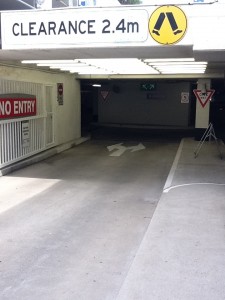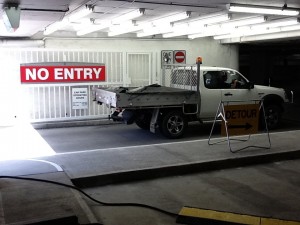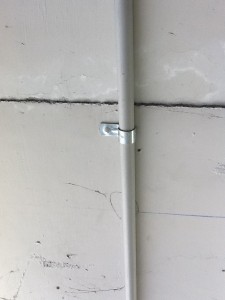13.08.2012
Designing Portal lighting
Today we are at the entrance of an underground car park in a large shoppping mall in Moore Park, NSW. The lighting design of Carpark entrances and exits are often neglected in the design process. Major problems that occur because of this have to be remediated after the building is completed, creating great inconvienance to the client and their customers, undermining the legitimacy of builders and designers. Owners or managers of car parks potentially face large litigation claims if accidents occur at entrances or exits to covered car parks where poor lighting is seen to contribute to any accident. If the safety of drivers and pedestrians has been comprised by having drivers enter a car park with the sun directly lighting the entrance and thus reducing their ability to see, then expect litigation to follow. This car park is case in point. Anecdotal evidence (see photos) indicates that the increase in lighting fixtures has occured after the buildings completion and wasn't included in the initial design phase (pre construction) The problem arises as the drivers eyes are adjusted for daylight and as the entrance is in full sun (and often painted white) the eyes iris adjust to read detail in the exterior opening leaving the internal carpark itself completely black as the driver enters this zone they are virtually blind and would not be capable of seeing any obstructions, obstacles or pedestrians in their path. To allievate this problem, the illumination levels in the opening area to the carpark, called the threshold Zone have to be increased, this increased illumination gives time for the iris to open to accommodate lower light levels. As the entrance speed to a carpark is usually 20 kmh, (unlike motorways where entrance speed is above 80kmh) the threshold Zone is a relatively short distance. To increase efficiency and aid in energy saving the luminaries can be linked to a daylight sensor that switches the lamps on or off as required (eg switched off at night when the drivers eye is accommodated for night vision
)
- Loss in productivity, through fatigue created by poor task lighting
- Community backlash, in the implied fear of the impact of obtrusive lighting on households and residents
Mrs. Dunk, who can see the lights of Mudgee from her highest property, also fears her property will be affected by lights from the Cobbora mine.
Source: Mudgee Guardian Newspaper Sept 11th 2011
- All aspects of the work must be effectively planned, from the physical process to the individual tasks carried out by employees. Both direct and indirect impacts on safety and health of each task or process should be considered at the planning level. This would include issues such as fatigue and psychological stress.
Source: General Duty of Care Guidelines provided by the Department of Mines
www.dmp.wa.gov.au/documents/Guidelines/MSH_G_GeneralDutyOfCareWAMines.pdf
Detailed proposals would be discussed with priorities of:
- Sustainability,
- Providing sufficient lighting on site to ensure that safety is not compromised.
- Appropriate lamp selection and the impact of colour rendering on the task,
- And compliance with all relevant standards and guidelines such as:AS4282—1997– Control of Obtrusive Effects of Outdoor Lighting




